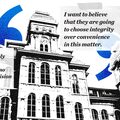How Scott Hanson’s Syracuse walk-on career prepped his broadcasting stardom
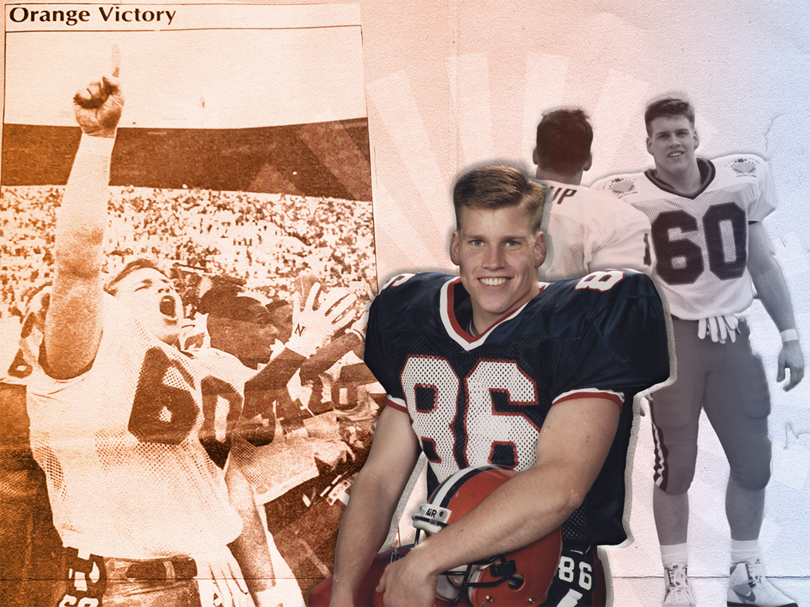
Scott Hanson started as a walk-on at Syracuse from 1989-92 before moving into his now-16-year stint as the host of "NFL RedZone." Collage by Ilana Zahavy | Presentation Director
Get the latest Syracuse news delivered right to your inbox. Subscribe to our sports newsletter here.
Scott Hanson sent a letter. Then another. Then another. Then four more before receiving a response to jumpstart his dreams.
The messages were addressed to Syracuse football head coach Dick MacPherson. Hanson, then a 17-year-old from Rochester, Michigan, provided simple information: his name, playing experience, height, weight and high school coach’s contact information.
As the summer before his freshman year at SU waned on, Hanson became paranoid. Did he have the wrong ZIP code? Why wasn’t he receiving a response? Then came a breakthrough.
In early July, Hanson finally heard back from an assistant coach on the Orange’s staff. He was invited to a four-day tryout to prove he belonged on the roster.
He made the team, paving the way to become one of sports media’s biggest stars.
Hanson has emerged as the face of NFL Sundays over the last 16 years while hosting the ever-popular “NFL RedZone,” evolving into the beloved guide for millions of football fans. Though from 1989-92 as he nurtured his broadcasting career at Syracuse, Hanson shined brightest as a walk-on and scout-team player amid some of the football program’s finest years. Now at 54, he credits his time with the Orange for fostering the passion invited weekly into living rooms worldwide.
His accolades continue to grow. Hanson starred on Gold Zone for the 2024 Paris Olympics, acted as the in-stadium host for the Super Bowl and is even featured in Madden 26. ESPN’s recent agreement to acquire NFL Network and the rights to “RedZone” caused an uproar from fans to confirm Hanson would remain the host, and speculation of expanding “RedZone” to other sports in the future.
“I want the television executives to think for this show to be a success, we have to have Hanson hosting it,” Hanson said. “It’s the same thought I had when trying to become a starter at Syracuse. It’s the same intensity, discipline and dedication that I approach my broadcasting career.”
Hanson headed for Syracuse in early August of 1989, unsure if he’d return home in four days or four months. He attended a Tom Petty concert with his high school friends, saying his final goodbyes before packing a week’s worth of clothing and his football gear for the tryout.
Scott Pioli, then an SU graduate assistant and future Super Bowl-winning executive, said the staff was looking for players who could boost the team’s overall morale. Hanson tried out as a long snapper and was mixed into offensive and defensive sessions on the first few days, largely to simulate drills. His overall enthusiasm quickly caught Pioli’s attention, even leading him to see if they could upset Hanson. They couldn’t.
Hanson eventually earned his chance to shine.
Many players participating were guaranteed spots on the team as recruits or preferred walk-ons. Hanson wasn’t one of them. Syracuse recruited just one specialist in the 1989 class in future NFL punter Pat O’Neill. The staff wanted to see O’Neill work out as both a punter and kicker, so it called on Hanson to deliver snaps.
As O’Neill lined up for extra points, Hanson got in his stance and torpedoed a snap through the holder’s hands. Assistant head coach Bill Maxwell shuffled in another holder. Hanson reached back, and again, the same result. Maxwell cycled through four or five guys, then entered the drill himself to see why no one could catch Hanson’s snaps.
He called for the snap, and the ball blistered straight through his hands, leaving him in awe. Maxwell turned skyward toward MacPherson in his coaching stand, shouting, “Hanson came here to snap!”
“I felt 10 feet tall,” Hanson said of the moment. “Somebody acknowledged not only that I was here to play, but that I was a human being. I got no recognition whatsoever in that four-day tryout. Except when I snapped.”
Hanson was eating lunch on the final day of the tryout when offensive coordinator George DeLeone approached him in the cafeteria. He told Hanson they liked what they saw in his snapping and to keep it up. DeLeone then walked away. Hanson was confused. Keep it up? Did I just make the team?
Hanson checked in with players around the cafeteria and told them what DeLeone said. They confirmed his thoughts. Hanson was on the roster.
He was excited. He accomplished his goal. Then, jubilation turned to a realization: he had more work to do to stick with the top talent in college football.
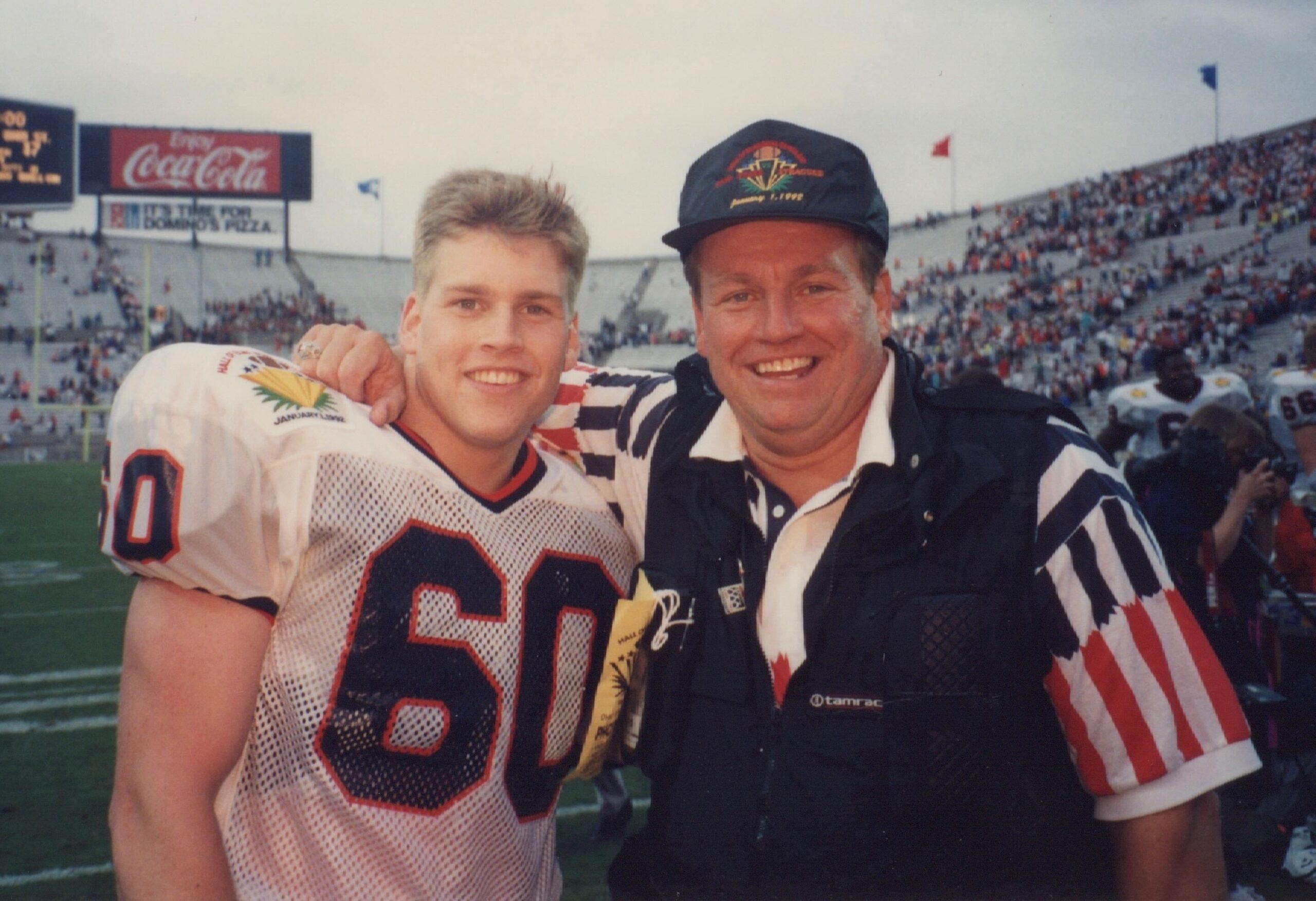
Scott Hanson (left) poses with his father, Jerry (right) at the 1992 Hall of Fame Bowl. Hanson remembers his dad paying for Syracuse newspapers to be shipped to their home in Michigan so he could read about the Orange’s season. Courtesy of Scott Hanson
When Hanson joined the Orange, they didn’t have many walk-ons. Then-assistant coach and future 14-year head coach Paul Pasqualoni said SU’s status as a private school often limited opportunities for walk-on candidates. But Hanson immediately stood out as someone who could contribute, they said.
Walk-ons in today’s game are scarce. The approval of the House v. NCAA settlement in June limits teams to a 105-player roster cap, equating to fewer spots for walk-ons. Schools can go over the limit to accommodate previous walk-ons or incoming players who expected a roster spot before the limits were imposed.
SU Director of Athletics John Wildhack told Syracuse.com in July that the university will stick with 85 scholarship players despite the ability to expand to 105. Walk-on spots will inevitably be cut across the country as time goes on. There may not be many more stories like Hanson’s.
Pasqualoni was a walk-on himself at Penn State under Joe Paterno in the late 1960s. He felt Hanson’s Syracuse teammates leaned on his energy and smile throughout his four years. George Rooks, a former teammate of Hanson’s and the father of a current Syracuse defensive lineman, said Hanson’s daily drive in practice motivated him and other top stars on the team. Rooks won a share of the 1991 Big East Defensive Player of the Year Award. Players like Hanson helped him enjoy the process.
“Those guys are the heartbeats of teams,” Rooks said. “It’s not the star football players, but the guys who’re here because they truly love the game. That’s who Scott is.”
At Bishop Foley Catholic High School in Madison Heights, Michigan, Hanson, a team captain, earned All-Conference honors. He received half-academic, half-athletic offers from smaller schools like Wayne State, John Carroll and Holy Cross. He was scrappy and undersized. But he was a student of the game. And he wanted to be a sports broadcaster.
Hanson was initially rejected from Syracuse University’s S.I. Newhouse School of Public Communications. A few weeks later, he reapplied. He was denied again. Hanson, however, was accepted into the Arts & Sciences College with an opportunity to transfer into Newhouse. He knew he couldn’t pass it up.
In the spring of his senior year of high school, Hanson’s football itch returned. He told his parents he didn’t want his football career to end and began sending letters to MacPherson. When he received his tryout offer, he jumped at the chance.
“It was big-time football. And I knew athletically, I was not a big-time football player,” Hanson said. “But I still wanted to try.”
Hanson wasn’t walking onto just any college football team. The Orange were among the best in the nation. SU went undefeated in 1987. In 1988, it finished 10-2. While Hanson was on the squad from 1989-92, Syracuse went 4-0 in bowl games and posted a 35-12-2 record. Each team featured multiple NFL players, and the 1992 team had Hall of Famer Marvin Harrison, then a freshman.
He needed to find his niche to survive. Hanson weighed 235 pounds at Bishop Foley and was the starting center. He cut weight entering college to gain athleticism. As the third-string snapper for the Orange, he never appeared in a game. But he dressed for every home game and traveled to all four bowl games with additional trips to the Tokyo Dome for the Coca-Cola Bowl in 1989 and Giants Stadium for the Kickoff Classic in 1990.
Hanson quickly became the personal snapper of four-year starting quarterback Marvin Graves. While the position groups, including offensive linemen, worked individually, Hanson delivered snaps to the quarterbacks to simulate a game-like scenario. A natural lefty, he learned how to snap right-handed to match starting center John Flannery. Hanson estimates he snapped more footballs to Graves than any other player.
“Scott snapped the ball like an NFL snapper,” Graves said. “I never played in the NFL. Flannery played in the NFL. Dave Wohlabaugh played in the NFL. I played tons of games in Canada, and I played with some pretty good centers. Scott’s velocity, accuracy and speed were up there.”
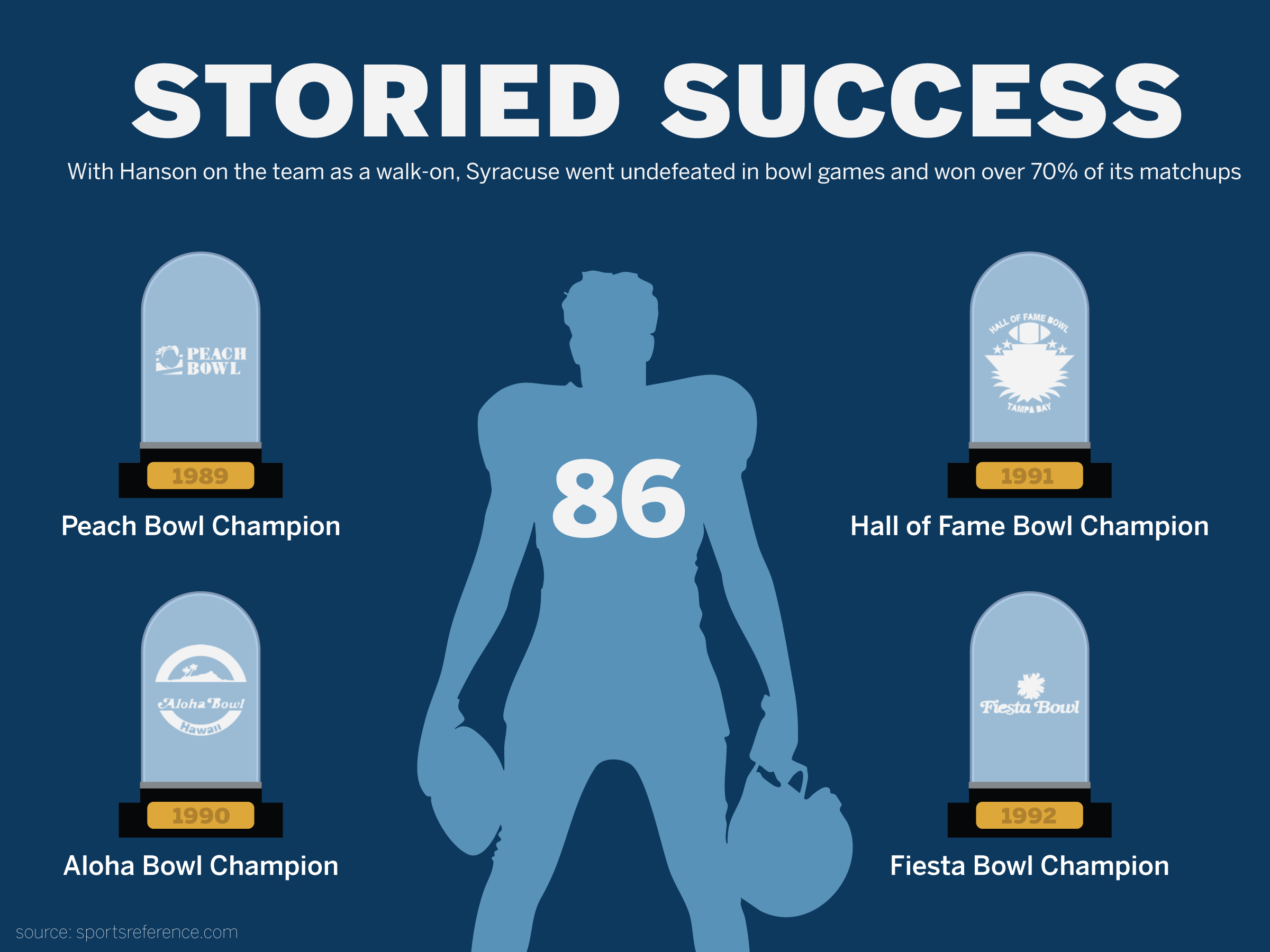
Sophia Burke | Digital Design Director
Besides snapping, Hanson was relied on as a scout team player. The lineup was made up of walk-ons like him and younger players often using their redshirts, giving them a chance to be part of the team.
Pioli said Hanson never missed anything. The scout team’s job was to mimic the opponent as closely as possible. Hanson was used all over but played a key role as a defensive back to give wide receivers similar looks to what they’d see in the game.
Star receiver Qadry Ismail remembers relying on Hanson to mirror the coverage of Virginia Tech cornerback Tyrone Drakeford. Ismail said Hanson’s aggressiveness matched Drakeford’s, allowing him to be ready come Saturday. Linebacker Reggie Terry thinks back to a specific instance during the 1991 campaign where Hanson emulated a Rutgers defensive back’s coverage, intercepting a pass.
DeLeone told Hanson he didn’t give a good look despite the interception because it was a coverage the Scarlet Knights wouldn’t play. A few days later, Rutgers safety Malik Jackson undercut a pass just like Hanson did, returning it 28 yards for a pick-six.
Aside from his play, Hanson’s personality grabbed many people’s attention. Fellow walk-on Kris Green said an 18-year-old Hanson reminded him of a combination between American Pie’s Steve Stifler — largely his mannerisms, not chasing women — and Anchorman’s Ron Burgundy. Running back Al Wooten classified him as a jokester.
Pioli saw his trash-talking as on par with former NFL quarterback Phillip Rivers as the best he’s seen on a football field. Defensive end Brian Tarrant said he was a guy you’d know within 15 minutes of walking into a room. His bubbly positivity never wavered.
“You only get one speed with Scott,” Tarrant said. “He’s got the radio voice and that’s always been his voice since we were young. The way he articulates and enunciates every single syllable of a word. That’s just who he is, and his personality is the same.”
His enthusiasm helped his teammates find strength. Defensive back Dwayne Joseph remembers a time when the Orange were practicing outside in the snow. Joseph, a Florida native, was miserable. Hanson loved it, hyping up Joseph and the scout team. Though it also got Hanson in trouble at times.
Early in his career, Hanson said he once turned to strength and conditioning coach Mike Woicik during warmups. The future Patriots staffer was stoic, often talking out of the side of his mouth in a monotone voice. Hanson enthusiastically shouted to Woicik, “Let’s have a great practice.” Woicik, knowing Hanson wanted to go into sports broadcasting, responded not so kindly.
“Hanson, you can take that Bob Costas act and shove it up your a**,” Hanson recalls Woicik saying. Hanson turned pale, not speaking to Woicik following the encounter.
But the “Bob Costas act” was exactly what Hanson was shooting for. After being rejected from Newhouse twice, Hanson was on a mission. He and his roommate, Jim Hockenberry, would purchase copies of USA Today from the dining hall. Hanson devoured the sports section. He also had subscriptions to outlets like Sports Illustrated, Sporting News and Sport Magazine to consume more football information. While playing with Syracuse, he was living the concepts.
Hanson was eventually admitted into Newhouse after a successful first few semesters. When football season was over, he and future NewsChannel 9 Sportscaster Dave Donovan took a cassette recorder into the stands at Henninger High School basketball games to do mock broadcasts. They alternated between play-by-play and color commentary, recording the game and listening back to critique later that night. Donovan said they treated it like it was a national NBC broadcast.
While millions now know Hanson’s NFL Sunday routine, he lived a similar one at SU. He’d have a light practice with the football team in the mornings, but the afternoons were free. Donovan, Hanson and others would head to Bleachers Sports Bar in Liverpool to catch all the action.
“NFL RedZone” couldn’t even be conceptualized back then. When the afternoon slate ended, Hanson honed in on NFL Primetime with Chris Berman to get a “10,000-foot view” of the league. He watched it religiously. And picked up on every broadcasting detail he could.
“I remember watching games with Scott and he would shush you because he wanted to hear what the announcer was saying,” Tarrant said.
During the NFL Draft, Hanson locked himself in his apartment to prepare notes and chart each pick with the player’s height, weight, position and more. Hockenberry, who lived with Hanson in Sadler Hall for two years before moving to the Skytop Apartments on South Campus, referred to the draft as Christmas to Hanson, giving him a card each year. The tradition has continued for over three decades, yet Hanson is now the in-stadium host for the draft.
But in practice, Hanson was taking a beating. The scout team was often referred to as the “demo squad” because of its ability to demonstrate opponents. But it could’ve been mistaken for the demolition squad.
Pioli remembers a time early in Hanson’s career when the freshman agitated Flannery. An offensive guard and Flannery then buried him into the ground. He popped up with his helmet sideways, still talking trash. Wooten also recalls when defensive tackle Kevin Mitchell went at it with Hanson. Hanson was a few inches shorter and about 50 pounds lighter than Mitchell and most of the defensive linemen he’d match up with.
“Scott was about the size of my left leg,” Rooks joked. “But he was willing. He’s a tough son of a b**ch. He didn’t back down.”
Hanson’s coaches also recognized his work. To celebrate the scout team each year, the staff would host an informal banquet and dinner at Varsity Pizza. They were served pizza and wings, and one player was named the Scout Team Player of the Year. In 1992, Hanson received the honor, earning a terry cloth, gray collared coach’s shirt. The shirt still sits in mint condition in his home in Los Angeles today, he said.
After earning the respect of his peers, Hanson became one of the guys. Hockenberry remembers players often coming to their apartment to play Joe Montana Football or the earliest versions of Madden on SEGA. Donovan said other times in the offseason, Hanson brought his teammates to Donovan’s for a barbecue or to watch “Monty Python.”
His goals on the football team weren’t just to connect with the school’s top athletes. He wanted to prove to himself that he could be excellent. Hanson was willing to make the sacrifices.
“The guy who runs the 4.4 (second) 40-yard dash who only goes 80% is going to get to the football the same time as the guy who runs the 4.9 at 100%,” Hanson said. “That’s what I tried to demonstrate for four straight years at Syracuse, and when I’m in the fifth, sixth or seventh hour of a ‘RedZone’ show.”
Hanson saw the star players up close and personal, understanding the human elements of the game. Fears. Insecurities. Failures. It’s a perspective many in his industry don’t possess.
There are specific rules that pop up once every few NFL seasons. Many wouldn’t know them. Hanson does because of the guidance from the Orange’s coaching staff. He also knows the preparation it takes for each team to excel on gameday. He lived it.
“He knows what it’s supposed to look like,” Pasqualoni said. “So when he looks at it, if it doesn’t look right, he knows there’s something wrong.”
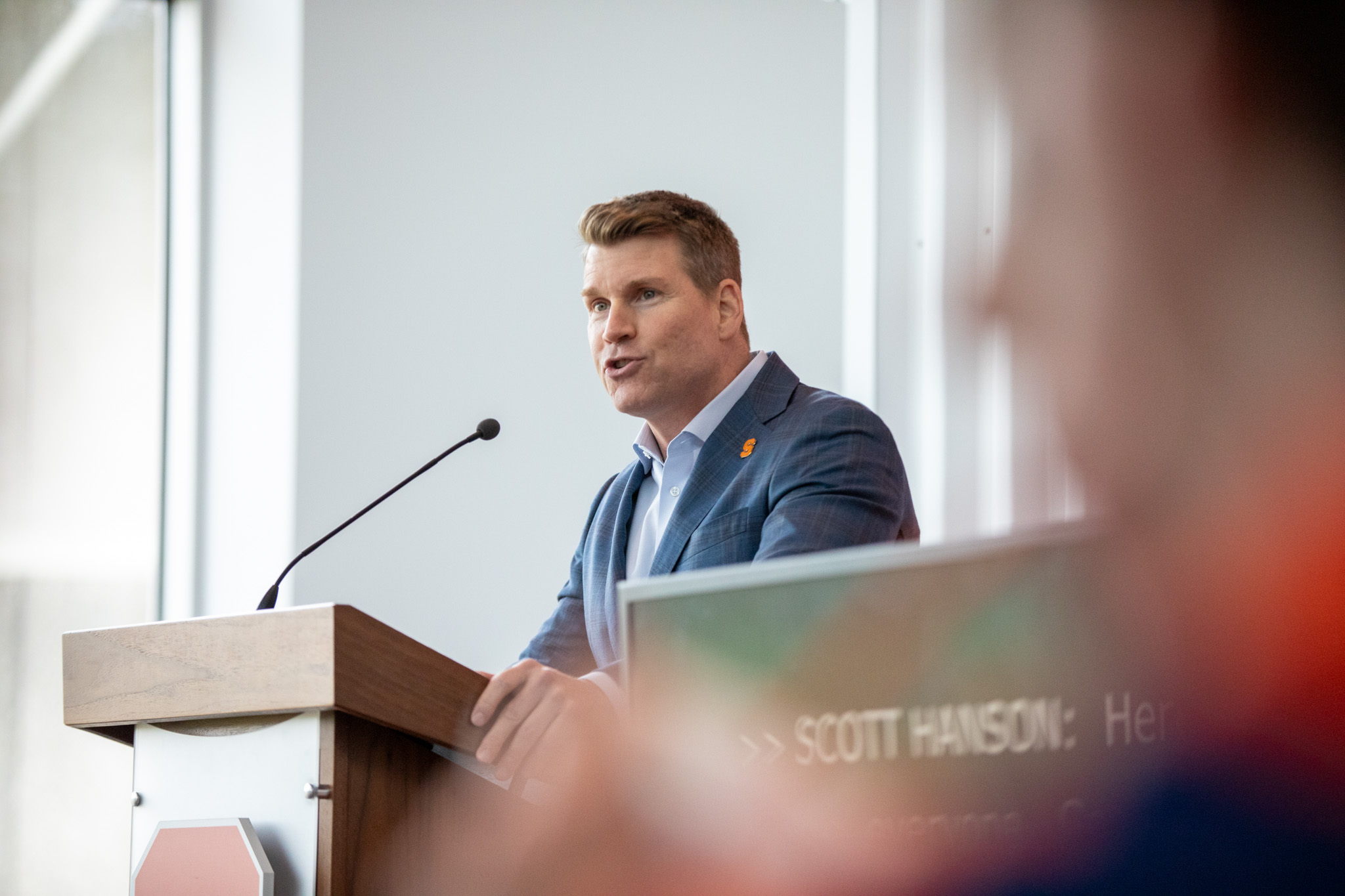
Scott Hanson speaks as the emcee at the ribbon-cutting ceremony for SU football’s new Football Performance Center at the John A. Lally Athletics Complex. Hanson was invited back by Director of Athletics John Wildhack. Leonardo Eriman | Photo Editor
It was Pasqualoni, too, who helped Hanson break into football broadcasting. Hanson remained at SU to finish his undergraduate studies in the fall of 1993. He was no longer on the football team but instead was reporting on it.
Hanson never had the chance to participate in Syracuse’s WAER radio station because of his football commitments. With his playing career over, Hanson contacted then-Sports Director and current ESPN announcer Dave Pasch to get involved. He pitched the idea of a sideline reporter, a role the station never had before. Hanson asked Pasqualoni for permission directly. The head coach liked the idea as long as it was Hanson. Thirty-two years later, a sideline reporter still roams the JMA Wireless Dome sidelines for WAER.
Many of Hanson’s former teammates played in the NFL. Some even have sons now vying to enter the league. Though Hanson has stood the test of time, becoming a mainstay on Sundays. And he’s helping Syracuse transition into its next generation.
Hanson received a call early in 2025 from Wildhack. The Orange were opening their new state-of-the-art Football Performance Center at the John A. Lally Athletics Complex in April, and Wildhack wanted Hanson to emcee the ribbon-cutting ceremony.
A few decades ago, Hanson was fighting to get into the program. Now, he’s one of the best to come out of it.
“If you could go back into a time machine to that four-day tryout in the late summer of 1989, the last person you would have picked to be standing front and center at the unveiling of this brand new, multi-million dollar football palace was Scott Hanson,” he said.




